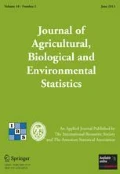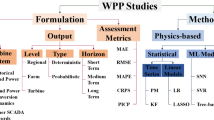Abstract
Renewable sources of energy such as wind power have become a sustainable alternative to fossil fuel-based energy. However, the uncertainty and fluctuation of the wind speed derived from its intermittent nature bring a great threat to the wind power production stability, and to the wind turbines themselves. Lately, much work has been done on developing models to forecast average wind speed values, yet surprisingly little has focused on proposing models to accurately forecast extreme wind speeds, which can damage the turbines. In this work, we develop a flexible spliced Gamma-Generalized Pareto model to forecast extreme and non-extreme wind speeds simultaneously. Our model belongs to the class of latent Gaussian models, for which inference is conveniently performed based on the integrated nested Laplace approximation method. Considering a flexible additive regression structure, we propose two models for the latent linear predictor to capture the spatio-temporal dynamics of wind speeds. Our models are fast to fit and can describe both the bulk and the tail of the wind speed distribution while producing short-term extreme and non-extreme wind speed probabilistic forecasts. Supplementary materials accompanying this paper appear online.




Similar content being viewed by others
References
Alexiadis, M., Dokopoulos, P., Sahsamanoglou, H. et al. (1999) Wind speed and power forecasting based on spatial correlation models. IEEE Transactions on Energy Conversion 14(3), 836–842.
Bakka, H., Rue, H., Fuglstad, G. A., Riebler, A., Bolin, D., Illian, J., Krainski, E., Simpson, D. and Lindgren, F. (2018) Spatial modelling with R-INLA: A review. WIREs Computational Statistics, 10: null. https://doi.org/10.1002/wics.1443.
Bivand, R., Gómez-Rubio, V. and Rue, H. (2015) Spatial data analysis with R-INLA with some extensions. Journal of Statistical Software 63(1), 1–31.
Casson, E. and Coles, S. (1999) Spatial regression models for extremes. Extremes 1(4), 449–468.
Castro-Camilo, D. and Huser, R. (2019) Local likelihood estimation of complex tail dependence structures, applied to us precipitation extremes. arXiv preprint arXiv:1710.00875 Submitted.
Cooley, D., Nychka, D. and Naveau, P. (2007) Bayesian spatial modeling of extreme precipitation return levels. Journal of the American Statistical Association 102(479), 824–840.
Davison, A. C. and Huser, R. (2015) Statistics of extremes. Annual Review of Statistics and its Application 2, 203–235.
Davison, A. C. and Smith, R. L. (1990) Models for exceedances over high thresholds. Journal of the Royal Statistical Society. Series B (Methodological) 52(3), 393–442.
Erdem, E. and Shi, J. (2011) ARMA based approaches for forecasting the tuple of wind speed and direction. Applied Energy 88(4), 1405–1414.
Fuglstad, G.-A., Simpson, D., Lindgren, F. and Rue, H. (2018) Constructing priors that penalize the complexity of Gaussian random fields. Journal of the American Statistical Association pp. 1–8.
Gneiting, T., Balabdaoui, F. and Raftery, A. E. (2007) Probabilistic forecasts, calibration and sharpness. Journal of the Royal Statistical Society: Series B (Statistical Methodology) 69(2), 243–268.
Gneiting, T., Larson, K., Westrick, K., Genton, M. G. and Aldrich, E. (2006) Calibrated probabilistic forecasting at the stateline wind energy center: The regime-switching space–time method. Journal of the American Statistical Association 101(475), 968–979.
Gneiting, T. and Ranjan, R. (2011) Comparing density forecasts using threshold-and quantile-weighted scoring rules. Journal of Business & Economic Statistics 29(3), 411–422.
Hering, A. S. and Genton, M. G. (2010) Powering up with space-time wind forecasting. Journal of the American Statistical Association 105(489), 92–104.
Hering, A. S., Kazor, K. and Kleiber, W. (2015) A markov-switching vector autoregressive stochastic wind generator for multiple spatial and temporal scales. Resources 4(1), 70–92.
Huang, Z. and Chalabi, Z. (1995) Use of time-series analysis to model and forecast wind speed. Journal of Wind Engineering and Industrial Aerodynamics 56(2–3), 311–322.
Huser, R. and Davison, A. (2014) Space–time modelling of extreme events. Journal of the Royal Statistical Society: Series B (Statistical Methodology) 76(2), 439–461.
Kazor, K. and Hering, A. S. (2015) The role of regimes in short-term wind speed forecasting at multiple wind farms. Stat 4(1), 271–290.
Koenker, R. (2005) Quantile Regression. Cambridge University Press, Cambridge UK.
Krainski, E. T., Gómez-Rubio, V., Bakka, H., Lenzi, A., Castro-Camilo, D., Simpson, D., Lindgren, F. and Rue, H. (2019) Advanced Spatial Modeling with Stochastic Partial Differential Equations using R and INLA. CRC press. Github version https://www.r-inla.org/spde-book.
Lenzi, A., Pinson, P., Clemmensen, L. H. and Guillot, G. (2017) Spatial models for probabilistic prediction of wind power with application to annual-average and high temporal resolution data. Stochastic Environmental Research and Risk Assessment 31(7), 1615–1631.
Lerch, S., Thorarinsdottir, T. L., Ravazzolo, F., Gneiting, T. et al. (2017) Forecaster’s dilemma: Extreme events and forecast evaluation. Statistical Science 32(1), 106–127.
Li, G. and Shi, J. (2010) On comparing three artificial neural networks for wind speed forecasting. Applied Energy 87(7), 2313–2320.
Lindgren, F., Rue, H. and Lindström, J. (2011) An explicit link between Gaussian fields and Gaussian Markov random fields: the stochastic partial differential equation approach. Journal of the Royal Statistical Society: Series B (Statistical Methodology) 73(4), 423–498.
Lombardo, L., Opitz, T. and Huser, R. (2018) Point process-based modeling of multiple debris flow landslides using INLA: an application to the 2009 Messina disaster. Stochastic Environmental Research and Risk Assessment 32(7), 2179–2198.
Naveau, P., Huser, R., Ribereau, P. and Hannart, A. (2016) Modeling jointly low, moderate, and heavy rainfall intensities without a threshold selection. Water Resources Research 52(4), 2753–2769.
Opitz, T., Huser, R., Bakka, H. and Rue, H. (2018) INLA goes extreme: Bayesian tail regression for the estimation of high spatio-temporal quantiles. Extremes 21(3), 441–462.
Palomares-Salas, J., De La Rosa, J., Ramiro, J., Melgar, J., Aguera, A. and Moreno, A. (2009) Arima vs. neural networks for wind speed forecasting. In Computational Intelligence for Measurement Systems and Applications, 2009. CIMSA’09. IEEE International Conference on, pp. 129–133.
Pinson, P. and Madsen, H. (2012) Adaptive modelling and forecasting of offshore wind power fluctuations with Markov-switching autoregressive models. Journal of forecasting 31(4), 281–313.
Riebler, A., Held, L., Rue, H. et al. (2012) Estimation and extrapolation of time trends in registry data—borrowing strength from related populations. The Annals of Applied Statistics 6(1), 304–333.
Rootzén, H., Segers, J. and Wadsworth, J. L. (2018) Multivariate peaks over thresholds models. Extremes 21(1), 115–145.
Rue, H. and Held, L. (2005) Gaussian Markov random fields: theory and applications. CRC press.
Rue, H., Martino, S. and Chopin, N. (2009) Approximate Bayesian inference for latent Gaussian models by using integrated nested Laplace approximations. Journal of the Royal statistical society: Series B (Statistical Methodology) 71(2), 319–392.
Rue, H., Riebler, A., Sørbye, S. H., Illian, J. B., Simpson, D. P. and Lindgren, F. K. (2017) Bayesian computing with INLA: a review. Annual Review of Statistics and Its Application 4, 395–421.
Scarrott, C. and MacDonald, A. (2012) A review of extreme value threshold es-timation and uncertainty quantification. REVSTAT–Statistical Journal 10(1), 33–60.
Shih, D. C.-F. (2008) Wind characterization and potential assessment using spectral analysis. Stochastic Environmental Research and Risk Assessment 22(2), 247–256.
Simpson, D., Rue, H., Riebler, A., Martins, T. G., Sørbye, S. H. et al. (2017) Penalising model component complexity: A principled, practical approach to constructing priors. Statistical Science 32(1), 1–28.
Tancredi, A., Anderson, C. and OH́agan, A. (2006) Accounting for threshold uncertainty in extreme value estimation. Extremes 9(2), 87.
Thibaud, E. and Opitz, T. (2015) Efficient inference and simulation for elliptical pareto processes. Biometrika 102(4), 855–870.
Zhu, X. and Genton, M. G. (2012) Short-term wind speed forecasting for power system operations. International Statistical Review 80(1), 2–23.
Acknowledgements
We thank Amanda Hering for helpful suggestions, and for providing the wind speed data. We also extend our thanks to Thomas Opitz for helpful discussion. Support from the KAUST Supercomputing Laboratory and access to Shaheen is also gratefully acknowledged. This publication is based upon work supported by KAUST Office of Sponsored Research (OSR) under Award No. OSR-CRG2017-3434.
Author information
Authors and Affiliations
Corresponding author
Additional information
Publisher's Note
Springer Nature remains neutral with regard to jurisdictional claims in published maps and institutional affiliations.
Electronic supplementary material
Below is the link to the electronic supplementary material.
Rights and permissions
About this article
Cite this article
Castro-Camilo, D., Huser, R. & Rue, H. A Spliced Gamma-Generalized Pareto Model for Short-Term Extreme Wind Speed Probabilistic Forecasting. JABES 24, 517–534 (2019). https://doi.org/10.1007/s13253-019-00369-z
Received:
Accepted:
Published:
Issue Date:
DOI: https://doi.org/10.1007/s13253-019-00369-z




